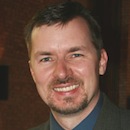Advisory Board and Editors Cell Biology

Daniel C Moreira
My research interests lie in the area of redox processes in biology and medicine. My main line of work investigates the role and underlying mechanisms of redox metabolism (i.e., reactive species and endogenous antioxidants) in animals during the depression of metabolic rate induced by environmental stresses, including projects that examine the modulation of antioxidant systems in animals exposed to oxygen deprivation and during other situations of metabolic depression. More recently and concurrently, I am also involved in the prospection of bioactive natural compounds (e.g., peptides from amphibians, plant extracts and phytochemicals) for health applications, with emphasis on antioxidant molecules.

Silvia N. J. Moreno
Professor of Cellular Biology and member of the Center for Tropical and Emerging Global Diseases of the University of Georgia. Former recipient of a Burroughs Welcome New Investigator Award. Undergraduate Coordinator of the Department of Cellular Biology.

Mirna Mourtada-Maarabouni
I was appointed at Keele as a Lecturer in the School of Life Sciences in August 2009. Prior to this, I obtained a first class BSc (Hons) in Biochemistry in 1995 and a PhD in cellular pharmacology in 1998, both from Keele. My research so far involved identifying and studying novel molecules involved in apoptosis.

Sushma Naithani
Sushma Naithani is an Associate Professor Senior Research in the Department of Botany and Plant Pathology at Oregon State University, USA. The current focus of her research is on understanding information flow in living systems and how evolution shapes this flow using systems-level pathway modeling supported by high-quality biocuration, gene-orthology-based predictions, and analysis of omics data. She serves as a senior curator for the Plant Reactome knowledgebase. Sushma has authored 31 peer-reviewed refereed research articles in high-impact journals, including Nature, Nature Biotech, PNAS, etc. One of her research papers has been selected by the 'Faculty of 1000 Biology'. In addition, she has authored six book chapters and one Open Textbook (S. Naithani (2021): History and Science of Cultivated Plants published by Oregon State University Open Educational Resources, EBOOK ISBN: 978-1-955101-08-0, available at https://open.oregonstate.education/cultivatedplants). She is also an Associate Editor for Frontiers in Plant Science-Plant Biotechnology and served as the Editor-in-chief of the Current Plant Biology (2017-2023).

Corey Nislow
Corey Nislow's laboratory develops and uses cutting edge tools to address this central question: how can we understand the biological commonalities in all of the life sciences; from embryonic development, to the spread of infectious diseases to better ways to treat cancer. Each of these disciplines can be explained in the context of competition, interaction and evolution. His lab studies the interface between genes and the environment using parallel genome-wide screens, high throughput cell-based assays and next generation sequencing. Most recently, he and his scientific partner, Dr. Guri Giaever, are exploring how laboratory experiments can co-opt evolutionary processes to understand drug action. He enjoys teaching all aspects of biotechnology, genomics and drug discovery. He got his PhD from the University of Colorado, worked at several Biotechnology companies and was at Stanford and University of Toronto before joining UBC in 2013. He has published 161 papers and run 19 marathons.

Olorunseun O Ogunwobi
Dr. Ogunwobi obtained a medical degree from the University of Ibadan, Nigeria, a master's degree in biomedicine from the University of Hull, United Kingdom, a master's degree in clinical and translational science from the University of Florida, Gainesville, and a PhD in molecular biology from the University of East Anglia, Norwich, United Kingdom. He was the Founding Director of the Hunter College Center for Cancer Health Disparities Research. He is now the Barnett Rosenberg Professor of Biochemistry and Molecular Biology and Chairperson in the Department of Biochemistry and Molecular Biology at Michigan State University. In addition, he will serve as Co-Director of the forthcoming Center for Cancer Health Equity Research (CCHER) at Michigan State University. He is a translational cancer biologist whose work focuses on molecular mechanisms of progression of solid organ cancers with racial disparities, and on approaches to leverage non-coding RNA biology for potential clinical applications in cancer. His work has been funded by the National Institutes of Health, New York State, Carnegie Corporation of New York, and the National Science Foundation, among others. Dr. Ogunwobi was a Founding Contact Principal Investigator of the Synergistic Partnership for Enhancing Equity in Cancer Health (SPEECH) funded by U54 grants CA221704 and CA221705 from the National Cancer Institute. An author of 74 peer-reviewed journal articles and 3 book chapters, Dr. Ogunwobi has been issued 5 US patents for biotechnology inventions with potential clinical applications in cancer. He is the recipient of the 2022 Hunter College Presidential Award for Excellence in Scholarship or Creative Activity, and selected as a Jefferson Science Fellow by the National Academies of Sciences, Engineering, and Medicine, and as a Fellow of the Academy of Medicine Specialties of Nigeria. He is Co-Founder of UTR Therapeutics, Inc (winner of the 2023 XSeed Award from Deerfield), and NucleoBio, Inc.

Sonia MR Oliveira
Doctor Sonia Oliveira holds a Licenciatura in Biology (pre-Bologna) and a Master in Cellular and Molecular Biology from the University of Aveiro, where she also specialized in medicinal plants, toxicology, murine models, and spermatogenesis. In 2011 she moved to Australia to work in Reproductive Biological Sciences. She later explored the nerve-cancer connection in Cancer, namely in female cancers, and completed her Ph.D. in Human Physiology ( with a significant component in Medical Biochemistry and Neurophysiology) from the University of Newcastle (Australia) in 2018. She then worked with biomimetic systems and nanotechnology in diabetes and stem cells. She explored multiple methods for primary and secondary cell culture, always with a keen interest in histopathology, cell biology, and rare disorders. Participated in >40 event(s). (Co-)Supervised MSc dissertation(s) and final projects for course completion of LSc/BSc. And works mostly in the area(s) of Natural sciences with emphasis on Molecular and Cellular Biology, and Medical and Health Sciences with emphasis on Neurosciences, Cancer, Reproduction, Toxicology, Biotechnology, and Stem cells. Also has collaborations in Microbiology, Biomaterials, and Communication and Information technologies.

Michael F Olson
Professor and Tier 1 Canada Research Chair in the Department of Chemistry and Biology of Ryerson University in Toronto Canada. Professor Olson's lab has focused on characterizing how Rho GTPase signalling pathways contribute to cancer, with the ultimate goal of identifying critical elements that could be targeted with small molecule inhibitors. Editor in Chief of the journal Small GTPases, and on the editorial boards of Molecular and Cellular Biology, Journal of Molecular Medicine, PLoS One, Scientific Reports. Science Proceedings, F1000 Research and PeerJ. Elected as a Fellow of the Royal Society of Biology.

Isabel M Palacios
University at Madrid, Spain; PhD at EMBL Germany; Postdoc at the Gurdon Institute, Cambridge, UK; Group Leader as a Royal Society University Research Fellow and currently as a University Senior Research Fellow, Cambridge, UK. Also a Fellow of St John's College, Cambridge, UK

Sean P. Palecek
Professor of Chemical & Biological Engineering at the University of Wisconsin - Madison.

Amaresh Chandra Panda
Dr. Panda obtained his Ph.D. in Biotechnology from National Centre for Cell Science, University of Pune, India. He worked as a Postdoctoral Fellow for five years at the National Institute on Aging, National Institutes of Health (NIH), Baltimore, USA. He also worked as an Assistant Scientist at the University of Miami, Miami, USA, and as a Postdoctoral Fellow at the University of Colorado, Denver, USA. His studies have uncovered new mechanistic details of the post-transcriptional regulation by RNA-binding proteins, microRNAs, and circular RNAs in physiological processes, including insulin production, myogenesis, and cellular senescence. In 2019, he was awarded the prestigious Intermediate Fellowship by Wellcome Trust/DBT India Alliance. Currently, he is working as a Scientist-D at ILS Bhubaneswar under the Department of Biotechnology, Government of India. His research group at ILS is working to understand the role of poorly characterized circRNAs in muscle regeneration and insulin biosynthesis.

Anurag N Paranjape
Passionate about understanding the mechanisms governing cancer metastasis with a hope of finding new targetable pathways. Have worked on breast cancer stem cells, EMT, prostate cancer stem cells, breast cancer brain metastasis, and blood-brain barriers.

